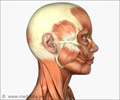- Muscular Dystrophy - (http://www.nlm.nih.gov/medlineplus/musculardystrophy.html)
- Muscular Dystrophy Information Page - (http://www.ninds.nih.gov/disorders/md/md.htm)
- Basic Human Genetics - Elaine Johansen Mange & Arthur P. Mange
- Medical Genetics - Lynn B. Jorde, John C. Carey, Raymond L. White
About Myotonic Dystrophy
Myotonic dystrophy is the most common form of muscular disease, which affects adults. The disease is also called as Steinert's disease, named after the doctor who first described it in the year 1909. The term myotonia is used to refer to a defect in the muscle fibers, that results in abnormal, prolonged muscular spasm. It is seen in approximately 1 in 7500 to 8000 live births.
The term muscular dystrophy is used to represent a group of muscle diseases characterized by muscle weakness and wasting of muscles. Several forms of muscular dystrophy are present among which the three most important ones are Duchenne Muscular dystrophy (DMD), facioscapulohumeral dystrophy, and myotonic Dystrophy. Myotonic dystrophy should not be confused with other forms of the disease. The characteristic feature of the disease, myotonia is not seen in any other form of muscular dystrophy. The disease be seen in newborn infants, at the time of birth (congenital MMD) or can manifest later during adolescence or adulthood (adult onset MMD).
The genetic disease is one of the best examples for a phenomenon called 'anticipation' in which the age of onset of the disease is early and the disease severity is greater in the successive generations. For example, a grandmother with the disease is only slightly affected, then mother is moderately affected and the grandchild severely affected. The disease might even be undetectable in the older generation while it may be severe enough to cause death in the recent generation.
The genetic defect responsible for myotonic muscular dystrophy has been traced to chromosome 19. The disease is transmitted in an autosomal dominant fashion; the disease is seen in every successive generation. Usually, equal number of males and females are affected. The disease may be transmitted from the father to son.










